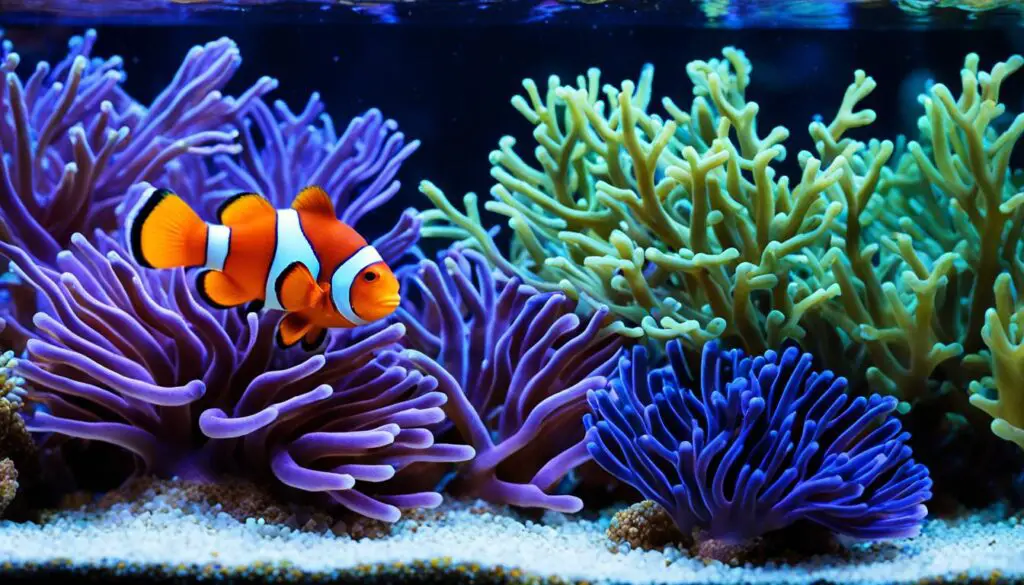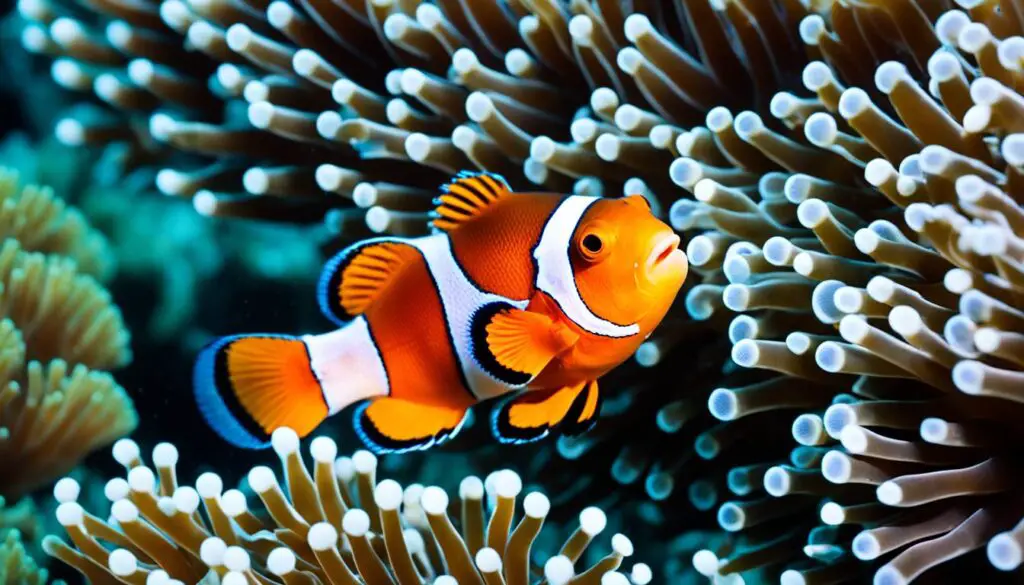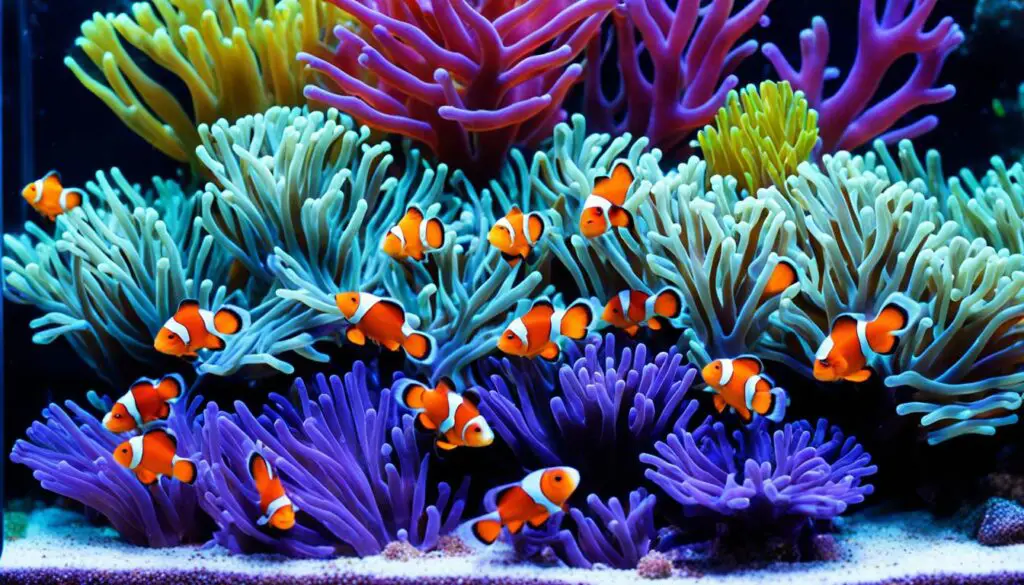The Ultimate Pet Fish Guide: Clownfish Care Tips

Welcome to “The Ultimate Pet Fish Guide”! I’ll give you top-notch clownfish care tips for a fantastic home aquarium for your pet fish. These tips work for newbies and pros. They make sure your clownfish are always happy and healthy.
For your clownfish, the tank size really matters. A 20-30 gallon tank is a good starting point. A larger tank is even better, needing less work and giving fish a stable home. Put in a good filter to keep the water clean. Devices like undergravel filters or protein skimmers can help a lot.
Now, aim for the right saltiness in the tank with marine salt. Add places for your fish to hide, like rocks and plants. Decorations are great, too. You can also add sea anemones for a natural feel, though they’re not a must.
Once the tank is ready, pick a good spot for it. Keep it out of direct sunlight and away from big temperature changes. Make sure the table or stand holding the tank is strong enough.
Key Takeaways:
- Buy a tank size of at least 20-30 gallons for clownfish.
- Ensure proper filtration to maintain a clean and healthy environment.
- Fill the tank with marine salt for the ideal salinity.
- Provide hiding places for the well-being of your clownfish.
- Place the tank in a safe location away from direct sunlight and temperature fluctuations.
Feeding and Maintenance
Feeding and taking care of your clownfish and their tank is very important. It’s key for their well-being and happiness. We’ll look into what they eat, the tank they live in, and how to keep everything clean and healthy.
Clownfish Diet
Clownfish are pretty easy to please when it comes to food. They love most types of marine fish flakes. You can find these at pet stores. Giving them a small amount of flakes once a day is good. But, if needed, they can go a couple of days between feedings.
It’s also great to mix up their diet with both plant and animal foods. You can add frozen or live items like brine shrimp, krill, and plankton to their meals. This variety is good for their health and keeps them happy.
Tank Conditions
To keep your clownfish healthy, the tank must be just right. There are a few things to keep in mind:
- Temperature: Clownfish like it warm, between 75-85°F (24-29°C). A good heater and a thermometer will ensure the temperature is steady.
- Lighting: Proper lighting is essential for a natural day/night cycle. A timer can keep the lighting schedule steady.
- Filtration: A working filter is a must to keep the water clean and safe for your fish. Check and clean it regularly.
Regular Maintenance
To keep your clownfish happy and healthy, regular chores are necessary. Here are some important tasks:
- Water Changes: Change about 10-20% of the water every 2-4 weeks. This keeps the water clean by removing toxins.
- Cleaning: Clean the tank glass and base often to avoid algae and waste buildup. Use the right tools to not harm your fish.
- Equipment Check: Check heaters, filters, and pumps often to make sure they are working. Replace anything that’s not working.
By keeping up with feeding and maintenance, you’ll provide a great home for your clownfish. This will help them live a long and healthy life.

Ocellaris Clownfish: Description and Compatibility
Ocellaris clownfish are a top pick for fish fans because of their color and charm. They have bright orange bodies with white stripes and dark edges on their fins. This makes them eye-catching in aquariums.
These fish need a big enough tank to stay healthy and happy. A 20-gallon tank is the minimum size you should have. It gives them room to swim, make their own areas, and act normally without being crowded.
In the wild, Ocellaris clownfish live in big, organized groups. Keeping them with their kind or in pairs can work. But, if you have more, you’ll need a larger tank to keep things peaceful and everyone happy.
They’re friendly and get along with calm fish and ocean bottom dwellers. Make sure their home has hiding spots and rocks. This helps them feel safe and mix well with others.
But, mixing them with other clownfish types can cause fights. Each kind of clownfish has its own space it wants. If you put them together, they might not socialize well in the tank.
Try to get clownfish that were raised in tanks, not taken from the wild. These tank-raised fish adjust better to life in a home tank. Buying them also supports the protection of the ocean’s coral reefs.
At a Glance: Ocellaris Clownfish Compatibility
| Tank Size | Social Behavior | Tankmates |
|---|---|---|
| Minimum of 20 gallons | Form social hierarchies, can be kept solo or in pairs | Non-aggressive reef fish and invertebrates |

Ocellaris clownfish, with their beautiful looks and calm ways, are great for saltwater tanks. Giving them the right home, friends, and care can lead to a peaceful and attractive tank.
Conclusion
Keeping clownfish as pets is both rewarding and teaches you a lot. Their happiness depends on how well you set up their home and keep it up. Ocellaris clownfish are perfect for those just starting because they are strong and easy to care for.
To keep ocellaris clownfish happy, they need a tank that’s at least 20 gallons and the right water conditions. It’s also crucial to give them different foods for a healthy life. You should know they like to be with others, so they’re fine alone or with a friend.
Always think about who you’re adding to the tank. Pick friends for your clownfish that get along with them. It’s best not to mix different types of clownfish to keep peace. If you want to help the environment, go for clownfish born in captivity. They adjust better and reduce the need to catch fish from the wild.
Follow these tips, and you’ll have a beautiful underwater world at home. It’s a great chance for you to explore and enjoy the sea with your own ocellaris clownfish.
FAQ
What size tank should I get for clownfish?
For clownfish, you’ll need a 20-30 gallon tank minimum. It’s better to go bigger to reduce upkeep and health risks. Smaller tanks need more care and might not stay clean.
Why is filtration important for clownfish tanks?
Small tanks with poor filtration can hurt your fish. Filtration systems keep the water clean by removing waste. For saltwater, undergravel filters or protein skimmers work well.
What should I fill the tank with for clownfish?
Fill it with marine salt to create the right home for your clownfish.
Do clownfish need sea anemones in their tank?
Clownfish don’t need sea anemones to be happy, but some people still like to add them.
Where should I place the clownfish tank?
Put the tank in a stable spot, out of direct sun and away from temperature changes. Make sure it sits on something strong enough to hold its weight.
What should I feed clownfish?
Clownfish like many marine flakes. Feed them a pinch daily. Every other day is okay, too. A mix of veggies and small animal foods is good for them.
What temperature should the tank be for clownfish?
Keep it between 75-85°F for the best clownfish life.
What tankmates are compatible with clownfish?
Ocellaris clownfish get along with peaceful reef fish and invertebrates. Just keep the same clownfish types together to avoid fights.
Should I buy captive-bred clownfish?
Yes, getting captive-bred clownfish is best. It’s good for their adjustment and for not harming the ocean reefs.
Why are ocellaris clownfish ideal for beginners?
Ocellaris are great for starters. They’re tough and happy in a 20-gallon tank with the right conditions.
How can I ensure the well-being of my clownfish?
Focus on a good tank setup and proper care. Feed them well and give them a home they love.
Are ocellaris clownfish social?
Yes, Ocellaris clownfish like being in pairs or on their own.



